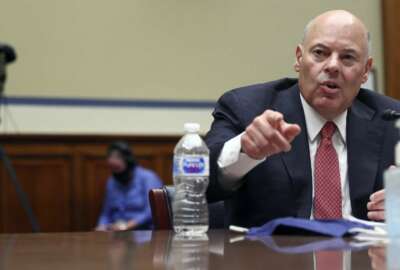To listen to the Federal Newscast on your phone or mobile device, subscribe in PodcastOne or Apple Podcasts. The best listening experience on desktop can be found using Chrome, Firefox or Safari.
- The early retirement and buyout offers the Federal Deposit Insurance Corporation made to its employees back in March are off the table. FDIC offered early retirements and buyouts to 20% of its workforce in early March before the pandemic. But the agency ended up withdrawing them less than two weeks later, as the pandemic hit its stride. The agency had said the buyouts and early retirements were not intended to reduce the size of the FDIC workforce, but instead a way to hire new employees with new skillsets.
- Federal chief data officers are mostly long-time civil servants. And they mostly report progress on developing data inventories and governance, as required under the law mandating their jobs. Those are among the findings of a CDO survey conducted by the Data Foundation and its corporate partners. Data officers also report a high level of collaboration with related officials, such as CIOs. But they also expressed a few challenges, like the need for more resources and more data literacy in agency workforces.
- The IRS doesn’t have the full picture on how many legacy systems it has or how expensive they are to maintain. The agency has flagged 45 systems to modernize and 34 to retire, but the Treasury Inspector General for Tax Administration says the IRS is missing key data on nearly half of its 669 systems that would determine whether or not they are legacy systems. The watchdog says the IRS does not track operations and maintenance costs by system, which makes it harder to prioritize which systems to retire first.
- President Donald Trump is directing the General Services Administration to put federal offices in qualified opportunity zones, other distressed areas and centralized community business areas. In a new executive order signed yesterday, the President is requiring GSA to develop programs to select, acquire, manage and dispose of federal space in a way that promotes these specific areas. Congress created qualified opportunity zones as part of the 2017 Tax Cuts and Jobs Act.
- More than 4,000 workers at one of the Navy’s largest shipbuilders are back at work after a months-long strike. Rank-and-file employees at Bath Iron Works in Maine approved a new three-year contract 63 days after first going on strike. The Machinists’ union says its workers got most of what they wanted, including concessions from the company on hiring subcontractors and three years of pay raises. The company says it is eager to get its production facilities back to full capacity. The yard was already 45 days behind schedule when the strike started, partly because of the coronavirus pandemic. (Federal News Network)
- Next-generation 5G capabilities enable data speeds 100 times faster than current-generation 4G networks and build a strong foundation for the Internet of Things. But moving more core functions to the edge of networks could create a larger attack surface for adversaries and introduce more vulnerabilities into agency and industry systems. In response, the Cybersecurity and Infrastructure Security Agency has released its strategy for protecting 5G networks. The strategy looks at expanding awareness of 5G supply-chain risks and sharing cyber-threat intelligence with industry partners.
- The Postal Service defended its cost-cutting efforts. Postmaster General Louis DeJoy says the Postal Service has cut nearly 3,000 late trips and 1,600 extra trips per day between mail-processing facilities and local post offices. That has led to a 70% reduction in these costs over the past four weeks. But DeJoy says the agency is taking longer than he expected to adjust to fewer trips. USPS data shows the agency has seen more than an 8% decline in on-time first-class mail, as well as similar delays for marketing mail and periodicals. (Federal News Network)
- Most participants still like the Thrift Savings Plan, but military members are a tougher sell. 87% of participants are satisfied with the TSP. That is according to a new survey of 5,000. Satisfaction among blended retirement system participants is lower though, at 77%. Participants who contribute more of their paychecks to their TSP are generally more satisfied with the plan. Half of participants contribute over 5%. Oddly enough though, participants with higher incomes say they cannot contribute 5% or more because they cannot afford it. (Federal News Network)
- For the first time since 1993, the Defense Department is updating the official ID cards it issues to military retirees and dependents. The new cards will look similar to the Common Access Cards DoD employees use, minus the chip that holds PKI certificates. DoD says the Next Generation Uniformed Services Identification Cards will be more secure. They are expected to completely replace the current laminated paper cards by 2026.
- The Office of Federal Procurement Policy is revisiting the concept of creating a governmentwide IT vendor management office. This was an idea from 2012 that never took off. But now OFPP, along with GSA, NASA and the National Institutes of Health Information Technology Acquisition and Assessment Center, plans to launch this new office in October, as part of the evolution of category management. The IT vendor management office will provide acquisition intelligence to other agencies to help them go from idea to strategy to contract award. (Federal News Network)
- Federal technology executives continue to shuffle chairs. The Education Department’s Federal Student Aid Office is getting a new chief information officer. The National Technical Information Service at the Commerce Department is losing its director, and a long-time cybersecurity executive is retiring. These are the latest in a string of changes in the federal technology community. At the Federal Student Aid Office, Mia Jordan is coming over from the Agriculture Department’s Rural Development bureau. Avi Bender will retire from NTIS at the end of September. And finally, John Felker, the assistant director for integrated operations at CISA, is retiring after 37 years in the public and private sectors. (Federal News Network)
- A new patient scheduling tool is live at its first Department of Veterans Affairs medical facility. The VA Central Ohio Healthcare System was the first to go live late last week with the centralized scheduling solution. The new scheduling system is a major component of VA’s ongoing electronic health record modernization. VA employees previously had to log into several systems to coordinate calendars, clinicians, rooms and equipment. But the new solution allows VA employees to schedule an appointment with one system and one screen. The new health record itself is supposed to achieve initial operating capability at VA sites later this fall.
Copyright
© 2024 Federal News Network. All rights reserved. This website is not intended for users located within the European Economic Area.




